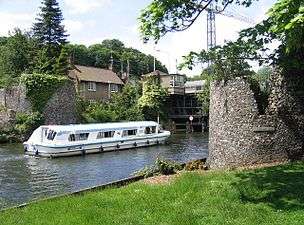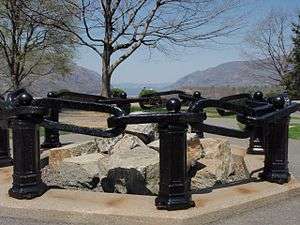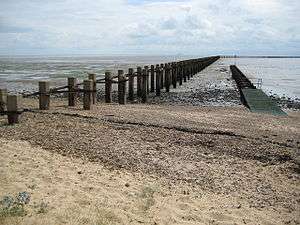Boom (navigational barrier)

A boom or a chain (also boom defence, harbour chain, river chain, chain boom, boom chain or variants) is an obstacle strung across a navigable stretch of water to control or block navigation.[1] Booms could be military in nature, with the goal of denying access to an enemy's ships; a modern example is the anti-submarine net. Booms could also be used, especially along rivers, to force passing vessels to pay a toll.[2][1]
Description
A boom generally floats on the surface, while a chain can be on the surface or below the water. A chain could be made to float with rafts, logs, ships or other wood, making the chain a boom as well.
Especially in medieval times, the end of a chain could be attached to a chain tower or boom tower. This allowed safe raising or lowering of the chain, as they were often heavily fortified.[1] By raising or lowering a chain or boom, access could be selectively granted rather than simply rendering the stretch of water completely inaccessible. The raising and lowering could be accomplished by a windlass mechanism or a capstan.[3]
Booms or chains could be broken by a sufficiently large or heavy ship, and this occurred on many occasions, including the Siege of Damietta, the Raid on the Medway and the Battle of Vigo Bay.[4][5][6][7]A Frequently, however, attackers instead seized the defences and cut the chain or boom by more conventional methods. The boom at the siege of Londonderry, for example, was cut by sailors in a longboat.
As a key portion of defences, booms were usually heavily defended. This involved shore-based chain towers, batteries or forts. In the Age of Sail, a boom protecting a harbour could have several ships defending it with their broadsides, discouraging assaults on the boom. On some occasions, multiple booms spanned a single stretch of water.
Gallery
-

Dutch crusaders break a chain protecting the harbour (at left) in the Siege of Damietta.
-

Boom towers in Norwich
-
Remains of the great chain that protected the Golden Horn
-

A preserved section of the Hudson River Chain
-

Remains of the Shoebury Boom, built to prevent U-Boats from entering the Thames Estuary during World War II
Examples
- The Leonine Wall included a chain blocking the Tiber
- A chain spanned the Golden Horn
- A chain and boom blocked the River Medway during the Raid on the Medway
- Hudson River Chain
- The chain blocking the Parana River during the Battle of Vuelta de Obligado
See also
- Anti-submarine net
- Boom defence vessel - a vessel charged with laying anti-submarine nets
- Log boom - a boom for collecting logs
- Boom (containment) - a boom for containing oil spills
Notes
- A.^ Some sources have the chain being dismantled instead of broken by a ship in the Siege of Damietta and in the Raid on the Medway.
References
- 1 2 3 Philip Davis (May 7, 2012). "Site types in the Gatehouse listings — Chain Tower". Gatehouse. Retrieved October 17, 2013.
- ↑ Boom Towers, Norwich
- ↑ Bob Hind (January 27, 2013). "Filling in the missing links on history of harbour chain". The News. Retrieved October 17, 2013.
- ↑ Gibbon, Edward. The History of the Decline and Fall of the Roman Empire, Volume 6. p. 510.
- ↑ "THE DUTCH IN THE MEDWAY - 1667". M.A. de Ruyter Foundation. Retrieved October 21, 2013.
- ↑ Hervey, Frederic (1779). The Naval History of Great Britain: From the Earliest Times to the Rising of the Parliament in 1779. W Adlard. p. 77.
- ↑ Long, WH (2010). Medals of the British Navy and How They Were Won. Great Britain: Lancer Publishers. p. 24. ISBN 9781935501275.